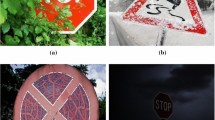Abstract
Traffic sign recognition is the second part of traffic sign detection and recognition systems. It plays a crucial role in driver assistance systems and provides drivers with crucial safety and precaution information. In this study, the recognition of the TS is performed based on its border color, shape, and pictogram information. This technique breaks down the recognition system into small parts, which makes it efficient and accurate. Moreover, this makes it easy to understand TS components. The proposed technique is composed of three independent stages. The first stage involves extracting the border colors using an adaptive image segmentation technique that is based on learning vector quantization. Then, the shape of the TS is detected using a fast and simple matching technique based on the logical exclusive OR operator. Finally, the pictogram is extracted and classified using a support vector machines classifier model. The proposed technique is applied on the German traffic sign recognition benchmark and achieves an overall recognition rate of 98.23%, with an average computational speed of 30 ms.








Similar content being viewed by others
References
Mogelmose A, Trivedi MM, Moeslund TB (2012) Vision-based traffic sign detection and analysis for intelligent driver assistance systems: perspectives and survey. IEEE Trans Intell Transp Syst 13(4):1484–1497
Maldonado-Bascon S, Lafuente-Arroyo S, Gil-Jimenez P, Gomez-Moreno H, Lopez-Ferreras F (2007) Road-sign detection and recognition based on support vector machines. IEEE Trans Intell Transp Syst 8(2):264–278
Ciresan D, Meier U, Masci J, Schmidhuber J (2011) A committee of neural networks for traffic sign classification. Int Jt Conf Neural Netw (IJCNN) 2011:1918–1921
Stallkamp J, Schlipsing M, Salmen J, Igel C (2011) The German traffic sign recognition benchmark: a multi-class classification competition. In: The 2011 international joint conference on neural networks (IJCNN), 2011. IEEE
Ciresan D, Meier U, Schmidhuber J (2012) Multi-column deep neural networks for image classification. In: 2012 IEEE conference on computer vision and pattern recognition (CVPR), 2012. IEEE
Ciresan D, Meier U, Masci J, Schmidhuber J (2012) Multi-column deep neural network for traffic sign classification. Neural Netw 32:333–338
Yingying Z, Xinggang W, Cong Y, Xiang B (2013) Traffic sign classification using two-layer image representation. In: 2013 20th IEEE international conference on image processing (ICIP), 2013
Timofte R, Zimmermann K, Van Gool V (2009) Multi-view traffic sign detection, recognition, and 3D localisation. In: 2009 workshop on applications of computer vision (WACV), 2009. IEEE
Liu H, Liu Y, Sun F (2014) Traffic sign recognition using group sparse coding. Inf Sci 266:75–89
Cai ZX, Gu MQ (2013) Traffic sign recognition algorithm based on shape signature and dual-tree complex wavelet transform. J Cent South Univ 20(2):433–439
Ohgushi K, Hamada N (2009) Traffic sign recognition by bags of features. In: Tencon 2009—2009 IEEE region 10 conference 1–4:1352–1357
Lim KH, Seng KP, Ang L-M (2012) MIMO Lyapunov theory-based RBF neural classifier for traffic sign recognition. Appl Comput Intell Soft Comput 2012:1–7
Almustafa KM (2014) Circular traffic signs recognition using the number of peaks algorithm. Int J Image Process (IJIP) 8(6):514
Almustafa K, Hamandi L, Zantout RN, Obeid HR (2012) Recognition of triangular traffic signs using the number of peaks algorithm. In: 2012 2nd international conference on advances in computational tools for engineering applications (ACTEA), 2012 pp 210–214
Moiseev B, Konev A, Chigorin A, Konushin A (2013) Evaluation of traffic sign recognition methods trained on synthetically generated data. In: Advanced concepts for intelligent vision systems. Springer
Chigorin A, Konushin A (2013) A system for large-scale automatic traffic sign recognition and mapping. CMRT13 City Models Roads Traffic 2013 ISPRS Ann Photogramm Remote Sens Spatial Inf Sci 2013(3):13–17
Stallkamp J, Schlipsing M, Salmen J, Igel C (2012) Man vs. computer: benchmarking machine learning algorithms for traffic sign recognition. Neural Netw 32:323–332
Cortes C, Vapnik V (1995) Support-vector networks. Mach Learn 20(3):273–297
Vapnik VN, Vapnik V (1998) Statistical learning theory, vol 1. Wiley, New York
Platt JC, Cristianini N, Shawe-Taylor J (1999) Large margin DAGs for multiclass classification. In: Proceedings of the 12th international conference on neural information processing systems. MIT press
Weston J, Watkins C (1998) Multi-class support vector machines. Technical Report CSD-TR-98-04, Department of Computer Science, Royal Holloway, University of London, May, 1998
Crammer K, Singer Y (2002) On the algorithmic implementation of multiclass Kernel-based vector machines. J Mach Learn Res 2:265–292
Pal M (2008) Multiclass approaches for support vector machine based land cover classification. arXiv preprint arXiv:0802.2411
Seo S (2005) Clustering and prototype based classification. PhD thesis, Fakultät IV Elektrotechnik und Informatik, Technische Universität Berlin, Germany
Biswas R, Tora MR, Bhuiyan FH (2014) LVQ and HOG based speed limit traffic signs detection and categorization. In: 2014 international conference on informatics, electronics & vision (ICIEV), 2014. IEEE
Lin S, Yao Y, Guo P (2010) Speed up image annotation based on LVQ technique with affinity propagation algorithm. In: Neural information processing. Models and applications. 2010, Springer, pp 533–540
Madani A, Yusof R, Maliha A (2015) Traffic sign segmentation using supervised distance based classifiers. In: The 10th Asian control conference (ASCC), 2015. IEEE: Kota Kinabalu, Malaysia
Sermanet P, LeCun Y (2011) Traffic sign recognition with multi-scale convolutional networks. Int Jt Conf on Neural Netw (IJCNN) 2011:2809–2813
Lee VW, Kim C, Chhugani J, Deisher M, Kim D, Nguyen AD, Satish N, Smelyanskiy M, Chennupaty S, Hammarlund P (2010) Debunking the 100× GPU vs. CPU myth: an evaluation of throughput computing on CPU and GPU. In: ACM SIGARCH computer architecture news, 2010. ACM
Zaklouta F, Stanciulescu B, Hamdoun O (2011) Traffic sign classification using K-d trees and random forests. Int Jt Conf Neural Netw (IJCNN) 2011:2151–2155
Author information
Authors and Affiliations
Corresponding author
Ethics declarations
Conflict of interest
The authors declare that they have no conflict of interest.
Rights and permissions
About this article
Cite this article
Madani, A., Yusof, R. Traffic sign recognition based on color, shape, and pictogram classification using support vector machines. Neural Comput & Applic 30, 2807–2817 (2018). https://doi.org/10.1007/s00521-017-2887-x
Received:
Accepted:
Published:
Issue Date:
DOI: https://doi.org/10.1007/s00521-017-2887-x




